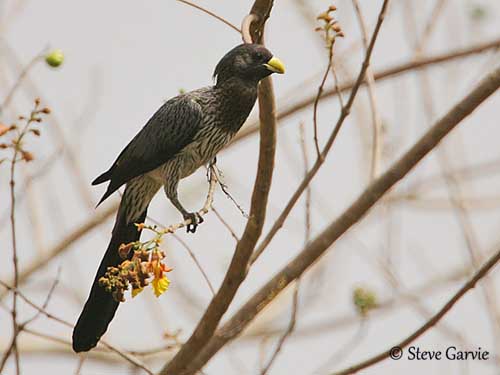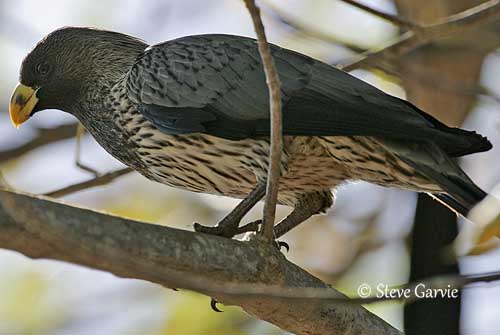
Fr: Touraco gris
All : Schwarzschwanz-Lärmvogel
Esp: Turaco Gris Occidental
Ital: Schizoro chiassoso occidentale
Nd: Grijze Bananeneter
Sd: Grå larmfågel
Photographers:
Steve Garvie
RAINBIRDER Photo galleries
Jean-Claude Jamoulle
A la rencontre des Oiseaux
Jean Marc Rabby
Des Ailes et des Plumes
Text by Nicole Bouglouan
Sources:
HANDBOOK OF THE BIRDS OF THE WORLD vol 4 by Josep del Hoyo-Andrew Elliott-Jordi Sargatal - Lynx Edicions - ISBN: 8487334229
BIRDS OF THE GAMBIA AND SENEGAL by Clive Barlow and Tim Wacher – Helm Field guides – ISBN: 0713675497
BirdLife International (BirdLife International)
Wikipedia, the free encyclopaedia
Western Grey Plantain-eater
Crinifer piscator
Musophagiforme Order – Musophagidae family
BIOMETRICS:
Length: 50 cm, including the tail of 24-25 cm
DESCRIPTION:
The Western Grey Plantain-eater is a West African species. Its call is one of the most familiar of this area.
The adult has dull grey plumage overall, with heavy dark streaking.
The upperparts are silvery-grey with dark brown spots. Upperwing-coverts are grey with dark shafts and spot at tip. We can also see narrow pale grey edges giving weak scaled pattern.
Secondaries and primary coverts are blackish-brown. Primaries are blackish with partially white inner webs, forming a white wing patch conspicuous in flight.
Rump and uppertail-coverts are grey with dark shafts. The tail is blackish-brown with grey central rectrices, turning dark brown towards the tip.

On the underparts, neck sides and upperbreast are dark brown with silvery wash and streaks. Lower breast, belly, flanks and undertail-coverts are white. Feathers have grey base and broad, brown shaft streak.
On the head, forehead, crown, lores, chin, throat and cheeks are dark brown. There is a shaggy nuchal crest made of narrow, pointed feathers of about 45 mm long. These feathers are brown with whitish edges.
The strong, large bill is bright yellow with slightly greenish base. Eyes are dark brown. Legs and feet are blackish.
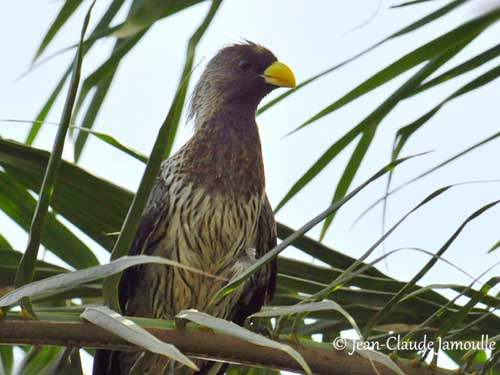
Both sexes are similar.
The juvenile resembles adult with shorter crest.
The immature has black woolly head.
VOICE: SOUNDS BY XENO-CANTO
The Western Grey Plantain-eater is often heard in the Gambian bus. This is a loud laughing or cackling uttered all day long and carrying over great distance “cow-cow-cow” and also “kalak-kalak-kalak” in display flight. They are highly vocal.
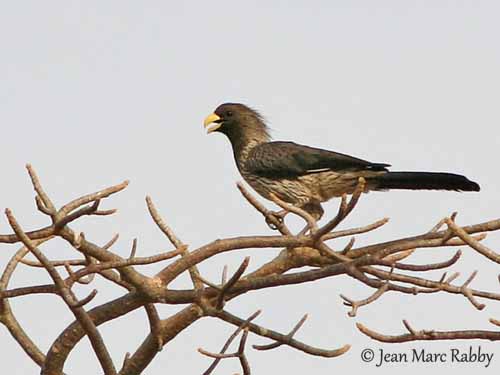
HABITAT:
The Western Grey Plantain-eater frequents various types of habitats, mainly in dry, open, wooded savanna and cultivated areas. It can be seen from sea-level up to 1300 metres of elevation.
RANGE:
The Western Grey Plantain-eater is found in S Senegambia, Sierra Leone and coastal Liberia, E to Central African Republic. It also occurs irregularly in Congo and Zaire.
BEHAVIOUR:
The Western Grey Plantain-eater is arboreal. It feeds on fruits, wild and cultivated, from several plant species. It also takes blossoms and leaves, seeds and invertebrates. As living in dry habitats, it comes frequently to the ground for drinking.
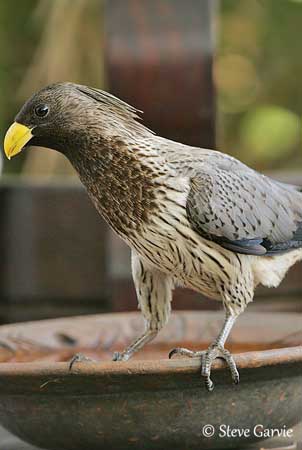
Like all turacos, this one is strongly territorial. They can be seen in family groups for long time. The group may travel large distances to find abundant food source such as a particularly favoured fruiting tree.
They usually approach and leave the food source in silence and in single file.
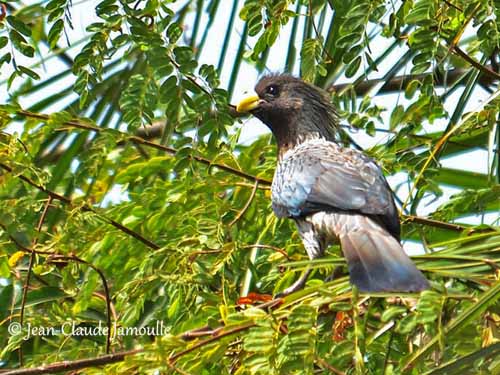
The Western Grey Plantain-eater breeds solitary and both mates defend strongly the territory. At the beginning of the breeding season, usually at the onset of rainfalls, we can hear much calling and several displays are reported.
The male performs flight displays during which it rises vertically from treetop, and then descends in a tumbling dive to its mate, while she remains perched with outstretched wings and tail.

Chasing from tree to tree, mutual feeding by regurgitated food and several postures are observed. The birds raise and lower their crest and they bow and fan their long tail. The white wing patches are exposed too.
They are monogamous with strong pair-bonds. Displays are accompanied with loud calls.
The Western Grey Plantain-eater is sedentary throughout its range.
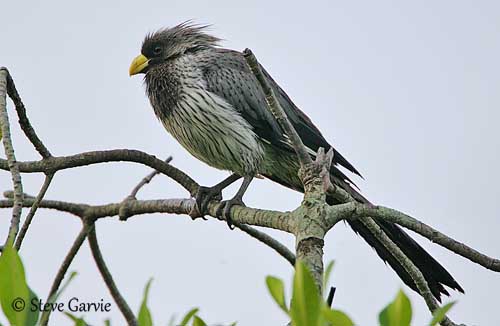
FLIGHT:
This species performs beautiful aerial displays, but like all turacos, its flight is laboured and weak. On the other hand, it is very agile along branches and through the vegetation.
REPRODUCTION:
The breeding season varies according to the range, and usually extends through the year.
The nest is a platform made with thin, dry sticks, of about 30 cm in diameter. This flat structure is placed in leafy tree, between 6 and 15 metres above the ground.
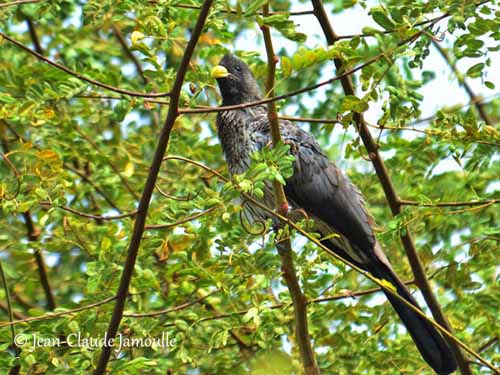
The female lays 2-3 slightly glossy greyish-white or bluish-white eggs. Both parents incubate during 27-28 days. The chicks are fed by regurgitation. They become active 2-3 weeks after hatching, and leave the nest to clamber about in the nearby branches. The first flight usually occurs at 4-5 weeks of age. The young still depend on parents for some weeks more.
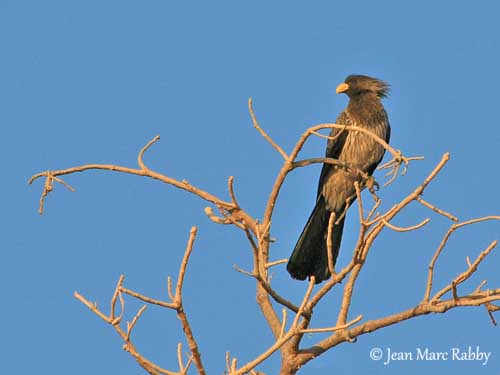
DIET:
The Western Grey Plantain-eater feeds on a variety of wild and cultivated fruits such as figs, mangoes, guavas, oil-palm fruits and dates. It also takes blossoms, leaves, seeds and invertebrates.
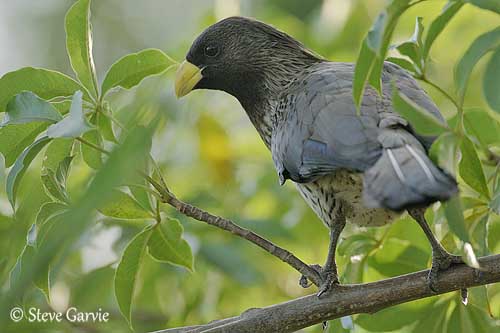
PROTECTION / THREATS / STATUS:
The Western Grey Plantain-eater is fairly common throughout its range and locally common in Senegal and The Gambia.
Its populations are not currently threatened.
